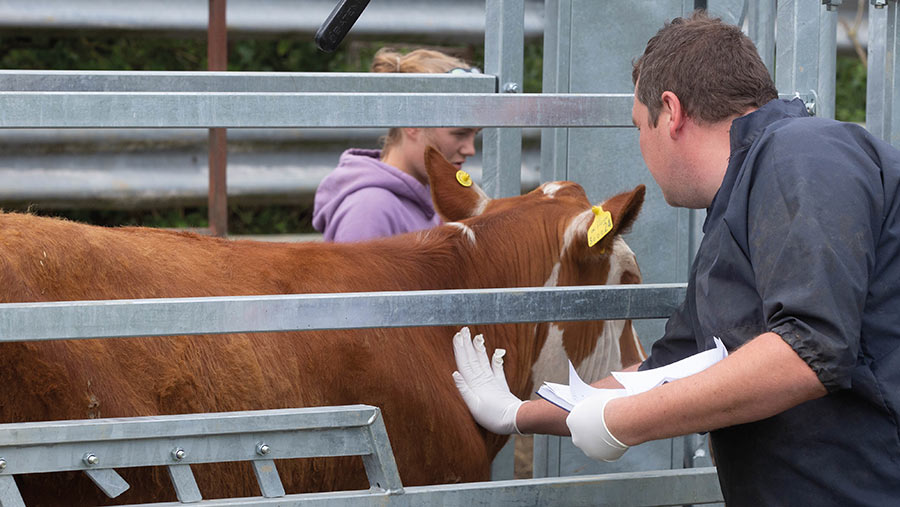3 steps to implement a bovine TB contingency plan
 © Tim Scrivener
© Tim Scrivener Farmers should carry out a three-step contingency plan to ensure they are prepared for the stress and potential financial implications of a TB breakdown.
This is according to Sarah Tomlinson of Westpoint Vets and the TB Advisory Service, who recently advised clients that it’s best to “hope for the best, but prepare for the worst”.
“A lot of farmers say there is huge stress and anxiety in waiting three days for the TB read day, so I’m telling clients to work out a plan beforehand,” she told a Dairy-Tech webinar last week (5 February).
She advised how to undertake a bovine TB contingency plan should movement restrictions be imposed, and reactors isolated and slaughtered.
See also: UK bovine TB rules, penalties and incentives
She said: “The mental health impacts of TB is often underestimated by the public, government and farmers themselves.
“Feeling the loss of stock and genetics that have taken generations to build up – not just the financial impact – is massive. This isn’t just about the potential end of a business, but the loss of a way of life, a vocation, and family homes.”
1. Assess effects if herd TB breakdown was to occur
- Heifer rearing away from home
- Selling breeding stock, stores or calves younger than 42 days
- Flying dairy herd – restrictions on buying in mean you can’t bring animals on to a TB-restricted holding until you have completed your first short-interval test – and even then the Animal and Plant Health Agency has to approve it
- Consider your milk contract – are there any penalties for over/underproduction and is calf euthanasia allowed?
- Effect on throughput and future cashflow of fatstock
2. Forecast business cashflow
- What happens if you can’t sell stores as planned?
- Can you afford bedding and feed to house and finish cattle?
- How would a smaller herd (due to fewer incoming cows – if a flying herd) affect production and profit?
- What effect would rearing all calves have on income and stocking density?
- Could you sell into an approved finishing unit (AFU)?
- Think long term – could a new shed being put up be badger-proofed and be suitable as an AFU/isolation unit? This needs to be planned, as it can only be applied for while the unit is TB-free
3. Evaluate short- and long-term actions
- Sell calves and youngstock following a clear pre-movement test, especially if movement restrictions would be in place over winter, to ease feed and space pressures
- Consider if becoming TB-accredited through the Cattle Health Certification Standards (Checs) TB scheme would be worthwhile
- Research local AFUs by checking the ibtb.co.uk map (they are marked as purple squares on the map). Ask them about age of cattle taken, prices and capacity
- Research other holding arrangements. These cannot be licensed once you have a breakdown, only before (see “Holding options and rules for TB-hit herds”)
- Check any orange markets nearby – these provide a trading option for clear-tested cattle from TB-restricted herds
Holding options and rules for TB-hit herds
AFU
There are three types of AFUs allowed in high-risk and edge areas – with grazing, without grazing and enhanced with grazing, which can take cattle from multi-TB-restricted and TB-free sources.
- No pre-movement test to enter from TB-free herds. Clear test needed within 90 days for officially TB-free suspended or withdrawn (OFTS/W) herds
- Often no surveillance testing
- Cattle must go to slaughter or another AFU
Isolation unit
A cattle-proof and badger-proof building that can take cattle in from a single OFTS/W source.
- A farm has six weeks to fill it and then it is closed
- If the unit passes two consecutive 60-day tests, it can sell animals as “clear-tested”, regardless of what is happening with the main herd
- They can be a separate business. If the main herd is shut down, the isolation unit can get “switched on”
Temporary land associations
This is like a linked holding and is a good option for animals that you want to return to the main herd.
- They have to be within 10 miles of the main holding and are classed as one epidemiological unit
- This could be useful if heifers are reared off farm nearby
- No pre-movement test is needed to move cattle between the units
Temporary county parish holdings (CPHs)
This arrangement is almost the opposite of a temporary land association. It is most suitable for cattle ultimately leaving the farm.
- You need to do a pre-movement test to move between the two units and show biosecurity protocols are in place if sharing equipment/personnel
- Two sites within one business could be separated with a temporary CPH
